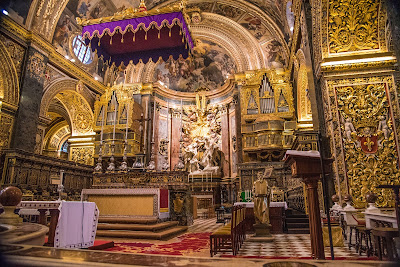During our visit to Malta we explored great little fishing villages, wonderful coastlines, mountain top cities and some beautiful countryside. We rented a car so that we could explore at our own pace and found that driving on this island presented some challenges but we are happy to report that we managed just fine. Malta is a welcoming place with warm and friendly people, great food and lots of colorful sights. Needless to say we had a great time.
 |
| we found a very colorful fishing fleet lives here |
Nothing says Malta like a traditional fishing village with an abundance of signature brightly colored fishing boats. We walked through the fish market and enjoyed some of the offerings.

 |
| Port of Gozo |
We took a ferry from the main island to the nearby island of Gozo where we took a coach through the countryside and then boarded a small boat to explore limestone caves and ventured out into the sea and along the cliffs.


 |
| exiting the passage/cave through the cliffs |
We really enjoyed our explore of the coastline where we jumped on a small boat and explored many limestone caves along the dramatic cliffs. Majestic!


]
Some of the sights on Gozo with its own fortified city on the mountain top.
 |
| The walled City of Mdina, the Silent City |
Back on the main island and high up in the hills we visited the fortified city of Mdina and the adjoining town of Rabat. This was the capital city of the island through the medieval times. The city was founded by the Phoenician settlers and then taken over by the Romans. Mdina was the center of the Maltese nobility and religious authorities after the capital was moved. It is nicknamed the Silent City.
 |
| St Pauls Cathedral |

A parade and the beautiful cathedral in Valetta, the current capital city of Malta.

The Catacombs of St Paul and the Church of St Paul and St Paul's Grotto in Rabat




The Church of St Paul in Rabat is built above a natural cave called a grotto. This is where it is believed that St Paul lived for three months while on the island of Malta. There is an elaborate entrance built above the cave now and a monument to St Paul.
Nearby to the church are the catacombs of St Paul. We spent a full afternoon going underground and climbing through the catacombs. A little spooky but very interesting.





















































